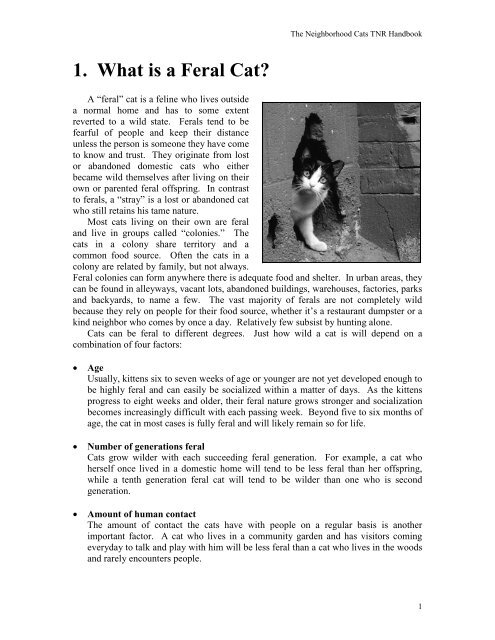You also want an ePaper? Increase the reach of your titles
YUMPU automatically turns print PDFs into web optimized ePapers that Google loves.
1. What is a Feral Cat?<br />
The <strong>Neighborhood</strong> <strong>Cats</strong> <strong>TNR</strong> <strong>Handbook</strong><br />
A “feral” cat is a feline who lives outside<br />
a normal home and has to some extent<br />
reverted to a wild state. Ferals tend to be<br />
fearful of people and keep their distance<br />
unless the person is someone they have come<br />
to know and trust. They originate from lost<br />
or abandoned domestic cats who either<br />
became wild themselves after living on their<br />
own or parented feral offspring. In contrast<br />
to ferals, a “stray” is a lost or abandoned cat<br />
who still retains his tame nature.<br />
Most cats living on their own are feral<br />
and live in groups called “colonies.” The<br />
cats in a colony share territory and a<br />
common food source. Often the cats in a<br />
colony are related by family, but not always.<br />
Feral colonies can form anywhere there is adequate food and shelter. In urban areas, they<br />
can be found in alleyways, vacant lots, abandoned buildings, warehouses, factories, parks<br />
and backyards, to name a few. The vast majority of ferals are not completely wild<br />
because they rely on people for their food source, whether it’s a restaurant dumpster or a<br />
kind neighbor who comes by once a day. Relatively few subsist by hunting alone.<br />
<strong>Cats</strong> can be feral to different degrees. Just how wild a cat is will depend on a<br />
combination of four factors:<br />
• Age<br />
Usually, kittens six to seven weeks of age or younger are not yet developed enough to<br />
be highly feral and can easily be socialized within a matter of days. As the kittens<br />
progress to eight weeks and older, their feral nature grows stronger and socialization<br />
becomes increasingly difficult with each passing week. Beyond five to six months of<br />
age, the cat in most cases is fully feral and will likely remain so for life.<br />
• Number of generations feral<br />
<strong>Cats</strong> grow wilder with each succeeding feral generation. For example, a cat who<br />
herself once lived in a domestic home will tend to be less feral than her offspring,<br />
while a tenth generation feral cat will tend to be wilder than one who is second<br />
generation.<br />
• Amount of human contact<br />
The amount of contact the cats have with people on a regular basis is another<br />
important factor. A cat who lives in a community garden and has visitors coming<br />
everyday to talk and play with him will be less feral than a cat who lives in the woods<br />
and rarely encounters people.<br />
1


